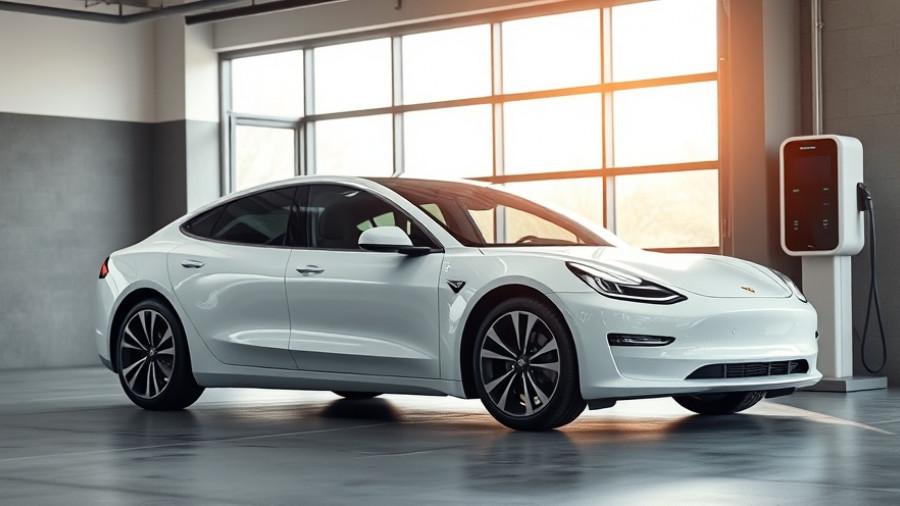
Tesla's Promising Q3 Performance: A Trend of Recovery Amid Sustainability Concerns
After a tumultuous start to the year, Tesla has managed to rebound significantly during the third quarter of 2025, posting a record revenue of $28.1 billion. This growth, reflecting a 12% increase from the previous year, marks a remarkable turnaround from the disappointing figures seen earlier. However, the lingering question surrounds Tesla's sustainability and whether this upward trajectory can be maintained, especially in light of intensifying competition and economic fluctuations.
Highs and Lows: A Closer Look at Tesla’s Q3 Figures
Tesla's automotive revenue grew to $21.2 billion—a modest 6% increase year-over-year—which, despite being a noteworthy figure, falls short of the peaks achieved in previous successful quarters. The company has successfully sold 497,099 electric vehicles (EVs) globally, signaling a strong recovery in demand, especially within the U.S. market, which saw its market share increase to 3.5%. This growth, however, coincided with the expiration of federal tax credits for EVs, suggesting a possible pull-forward in demand as consumers rushed to make purchases before incentives vanished.
Rising Costs and Shrinking Margins: A Fragile Growth Model
Despite seemingly optimistic sales figures, Tesla's profit margins remain a concern. With a net income of $1.37 billion, the company has seen its profits drop significantly—down by 37% compared to the previous year. Rising operating expenses, tariffs, and lower revenues from CO2 credits have all contributed to this margin squeeze. Indeed, the operating margin is only at 5.8%, revealing that Tesla's cost structure is becoming a challenge. As reported by Seeking Alpha, competition from executives like BYD and the new line of electric vehicles from traditional automakers exacerbates this situation, raising significant questions about Tesla's long-term viability.
Trends in Tesla’s Energy Business: A Bright Spot Amidst Challenges
One encouraging aspect of Tesla's operations is the remarkable growth in its energy business, which saw a notable 44% increase in revenue to $3.42 billion in Q3. Sales in this segment, which encompasses solar products and energy storage solutions, make up about a quarter of Tesla’s overall revenue. As demand for sustainable energy solutions grows, this area could provide a crucial buffer against the slower growth rates seen in Tesla’s automotive sales.
Emerging Technologies: Tesla's Long-Term Vision and Its Implications
Looking ahead, Tesla is heavily investing in autonomous driving technologies and plans to scale its Robotaxi service across several metro areas in the near future. CEO Elon Musk’s ambitious vision of a fully operational robotaxi fleet is designed to pivot Tesla into a tech-driven enterprise rather than just an automaker. However, the slow rollout of the Full Self Driving (FSD) feature raises eyebrows among investors who are concerned about the timing and viability of these advancements.
Market Dynamics: Can Tesla Sustain Growth?
The dynamics in the electric vehicle market are evolving rapidly, with increased competition signaling that Tesla's past strategies may need reevaluation. As highlighted in both reference articles, analysts warn that while Tesla's growth is commendable, it is primarily driven by factors unlikely to last. The closing of tax credits, rising operational costs, and a potentially receding interest from consumers at higher price points all suggest that while Tesla is back on track for now, its journey ahead will require strategic reforms and possibly, a redefinition of its business model.
Conclusion: The Need for Strategic Adaptation
In conclusion, while Tesla’s solid performance in Q3 is a beacon of hope post a rough first half, the sustainability of this growth hangs in the balance. Homeowners and businesses interested in green energy solutions should keep a keen eye on how Tesla adapts to market demands and leverages its energy sector benefits for continued resilience. As investors consider the implications of Tesla's quarterly performance, understanding these dynamics becomes crucial in perceiving the future of electric vehicles and renewable energy technology.
For a deeper dive into sustainable energy solutions, explore Tesla’s evolving role in the energy sector and its impact on the future of renewable technologies.
 Add Row
Add Row  Add
Add 



Write A Comment